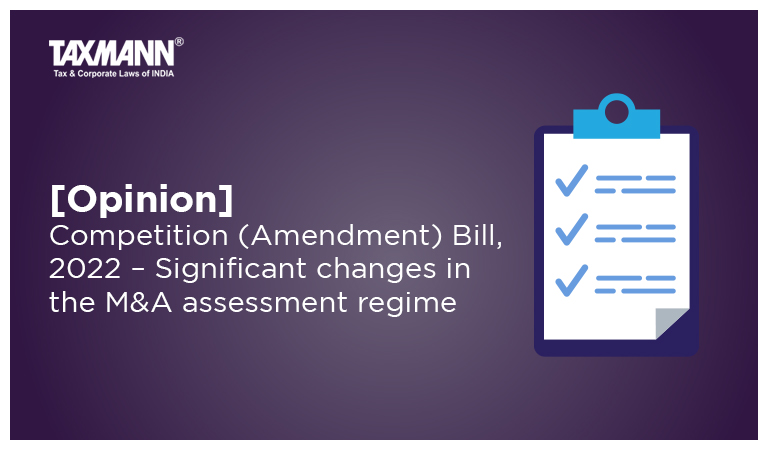[Opinion] Competition (Amendment) Bill, 2022 – Significant changes in the M&A assessment regime
- Blog|News|Competition Law|
- 3 Min Read
- By Taxmann
- |
- Last Updated on 16 August, 2022
[2022] 141 taxmann.com 222 (Article)
Good institutions learn from their experience. Hence, after more than a decade of implementation of the M&A assessment provisions of the Competition Act, 2002 (“Act”), Competition (Amendment) Bill, 2022 (“Bill”) seeks to capitalise on the experience gained by the Competition Commission of India (“CCI”) by proposing significant changes in the M&A assessment regime. Following paragraphs discuss these changes:
- Introduction of deal value threshold: As on date, only M&As that cross the thresholds specified in section 5 of the Act amount to ‘combination’ requiring prior approval of the CCI. These thresholds are in terms of assets and turnover of the parties (as well as the groups involved) to the transaction. However, many significant transactions escaped CCI’s assessment as the parties did not cross the applicable thresholds. To ensure that such transactions do not escape the purview of the CCI, the Bill seeks to introduce deal value thresholds so that transactions:
(a) with a deal value in excess of INR 2,000 crore (approx. USD 252 million); and
(b) where either party has ‘substantial business operations in India’will need to notify and seek prior approval of the CCI. What amounts to ‘substantial business operations in India’ or the ‘local nexus’ thresholds will be specified through the appropriate regulations.
It will have to be seen if the Central Government carries out corresponding changes with respect to the small target exemption/ de minimis exemption. As on date the said exemption, exempts transactions wherein the assets of the target in the transaction are less than INR 350 crores or if it has turnover of less than INR 1000 crores. It may be recalled that the recent acquisition of INOX by PVR’s, which gave the combined entities significant market power in the market for multiplex cinemas, did not require prior approval of the CCI as it benefitted from the de minimis exemption.
- Change in definition of ‘control’: The definition of ‘control’ is very important for the purpose of assessing the thresholds, as it determines the entities that belong to a ‘group’. It is also required to assess whether a combination can benefit from regulation 4 of The Competition Commission of India (Procedure in regard to the transaction of business relating to combinations) Regulations, 2011 (“Combination Regulations’) and be categorised as a Combination not likely to have appreciable adverse effect on competition (“AAEC”) in India. Presently the statute defines control as including ‘controlling the affairs and management’ of one enterprise by another enterprise. The Bill seeks to expand this definition to mean’the ability to exercise material influence, in any manner whatsoever, over the management or affairs or strategic commercial decisions’. This is based on the various precedents whereby the CCI had given an expansive interpretation to the definition of control.
- Definition of Turnover: The Bill proposes to introduce the following definition of ‘turnover’:
“”turnover” means the turnover certified by the statutory auditor on the basis of the last available audited accounts of the company in the financial year immediately preceding the financial year in which the notice is filed under sub-section (2) or sub-section (4) of section 6 and such turnover in India shall be determined by excluding intra-group sales, indirect taxes, trade discounts and all amounts generated through assets or business from customers outside India, as certified by the statutory auditor on the basis of the last available audited accounts of the company in the financial year immediately preceding the financial year in which the notice is filed under sub-section (2) or sub-section (4) of section 6″
The aforesaid definition also includes the definition of ‘turnover in India’ (for the purposed of local nexus thresholds) and clearly excludes intra-group sales, indirect taxes, trade discounts and all amounts generated through assets or business from customers outside India.
Click Here To Read The Full Article
Disclaimer: The content/information published on the website is only for general information of the user and shall not be construed as legal advice. While the Taxmann has exercised reasonable efforts to ensure the veracity of information/content published, Taxmann shall be under no liability in any manner whatsoever for incorrect information, if any.

Taxmann Publications has a dedicated in-house Research & Editorial Team. This team consists of a team of Chartered Accountants, Company Secretaries, and Lawyers. This team works under the guidance and supervision of editor-in-chief Mr Rakesh Bhargava.
The Research and Editorial Team is responsible for developing reliable and accurate content for the readers. The team follows the six-sigma approach to achieve the benchmark of zero error in its publications and research platforms. The team ensures that the following publication guidelines are thoroughly followed while developing the content:
- The statutory material is obtained only from the authorized and reliable sources
- All the latest developments in the judicial and legislative fields are covered
- Prepare the analytical write-ups on current, controversial, and important issues to help the readers to understand the concept and its implications
- Every content published by Taxmann is complete, accurate and lucid
- All evidence-based statements are supported with proper reference to Section, Circular No., Notification No. or citations
- The golden rules of grammar, style and consistency are thoroughly followed
- Font and size that’s easy to read and remain consistent across all imprint and digital publications are applied








 CA | CS | CMA
CA | CS | CMA


